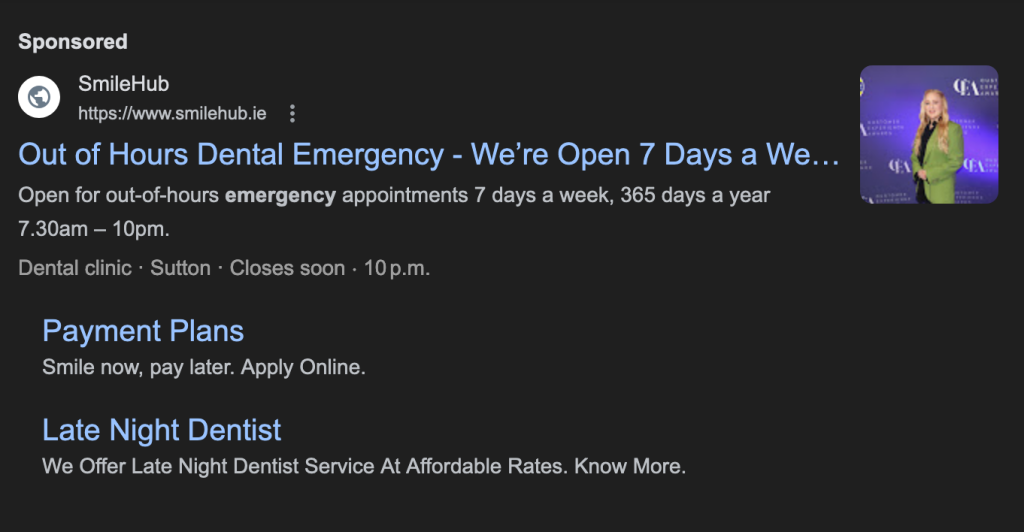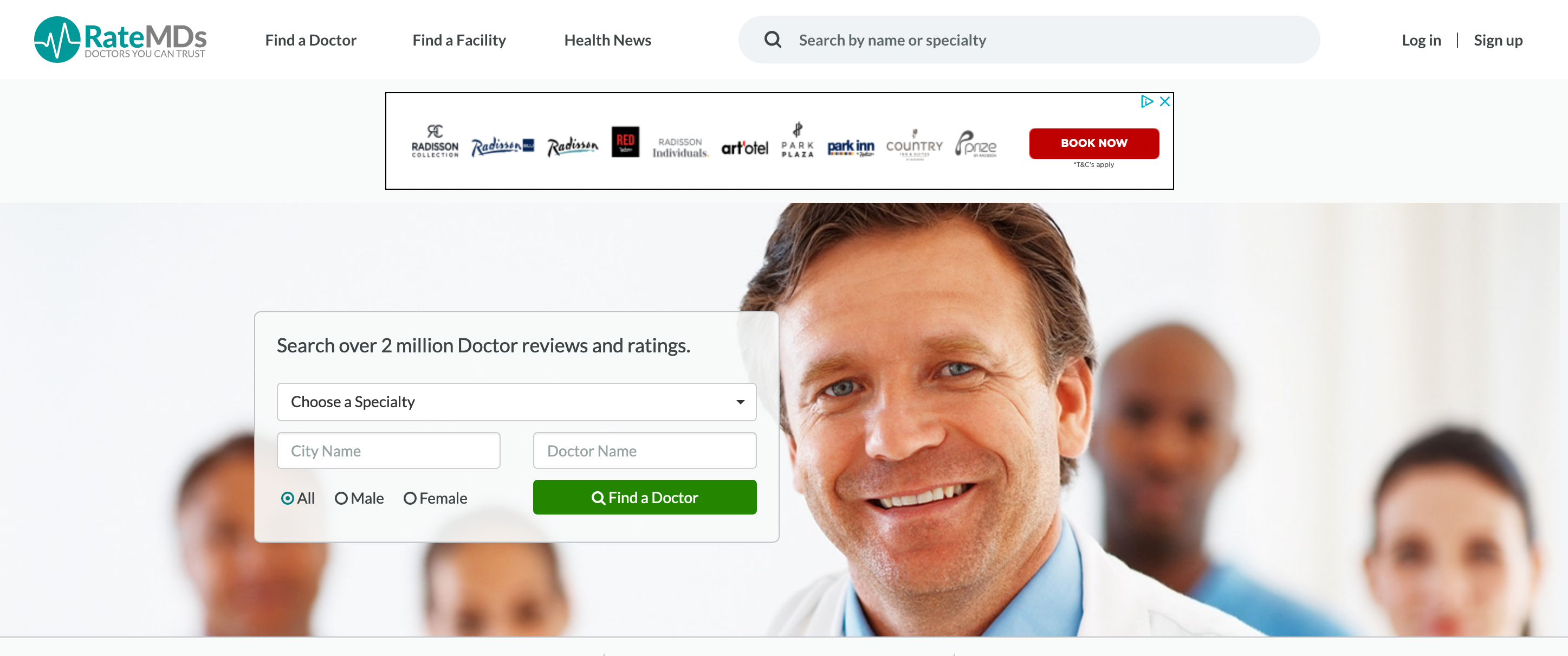Think of your healthcare practice as a bit like running a restaurant. You need to attract customers, offer them a great experience, and keep them coming back for more.
Your advertising strategy is your menu – it’s how you show your specialties and entice people to give your services a try.
But unlike a static menu, your advertising needs to be dynamic and adaptable. It needs to reach the right people at the right time with the right message.
In this guide, we’ll explore the ingredients of a successful healthcare advertising strategy, from the appetizers of Google Ads to the main courses of Facebook campaigns. We’ll even offer some chef’s specials for dentists, eye care providers, and more.
Let’s show you how to fire up the ovens and cook up a winning strategy.
Types of healthcare advertisements

The healthcare industry is rapidly evolving, and with it, the way patients seek information and services. Healthcare establishments – from hospitals to private practices – must adapt their marketing strategies to reach their target audience.
A strong online presence is no longer a luxury, but a necessity for attracting and retaining patients.

Consider this:
5% of all Google searches are health-related, meaning a significant portion of prospective patients are actively searching for solutions online. To reach this audience, you need a multi-channel digital strategy.
Here’s how different mediums of communication contribute to a successful healthcare advertising campaign:
- Targeted Google Ads: Capture the attention of patients actively searching for specific healthcare services.
- A user-friendly website: Provide easy access to information about your practice, services, and medical professionals.
- Engaging social media content: Build brand awareness and connect with future patients on a personal level, potentially even featuring endorsements from healthcare professionals.
- High-quality content marketing: Establish your practice as a trusted resource within the healthcare field.
For the majority of this article we’ll be focused on two tried and true online marketing methods: Facebook and Google.
Pro Tip: Managing a diverse advertising campaign can be complex. Consider partnering with a skilled digital marketing agency to optimize your strategy and free up your time for patient care.
Dental advertisements

Did you know only 28% of healthcare marketers are constantly optimizing their content marketing strategy?

This puts you at a huge advantage if you get it right.
Let’s explore two key platforms—Facebook and Google—to see how they can work for you.
Facebook ads for dentists

Using social media platforms like Facebook for dental advertisements allows practices to reach a broader target audience.

With 74% of high-income earners using Facebook, dentists can use this platform to promote everything from routine cleanings to complex procedures.

(Source)
Meta’s Advantage+ Audience tool further simplifies patient acquisition by automatically targeting people who are most likely to engage with the ads. This tool optimizes your marketing efforts, helping dentists generate more interest and increase interaction.

The use of paid media for dental practices has also proven to be highly beneficial, with an average conversion rate of 9.83%.
By implementing digital marketing strategies and well-structured marketing campaigns, dental practices can increase their visibility and engagement across social media platforms.
Let’s look at two examples of Facebook Ads done right – both from Toronto’s Little Green Building Family Dentistry
Example 1: Flossing Tips Blog Post

The first ad from Little Green highlights how sharing educational content about preventive care – like flossing tips – can strengthen the practice’s connection with healthcare consumers. This type of content not only helps build trust but also encourages potential patients to explore the services offered.
Example 2: Root Canal Blog Post

The second example from Little Green focuses on a more complex topic: root canals. Sharing information about procedures creates valuable content opportunities that build the practice’s credibility and encourage patient engagement.
Pro Tip:
Facebook ads for healthcare – including dental practices – face strict targeting and content rules to protect privacy. Avoid sensitive health-related targeting and ensure your ad copy focuses on patient education and value-based information
Google ads for dentists

While Facebook excels at driving patient engagement, Google Ads offers a powerful tool to reach prospective patients actively searching for your dental services.
As we approach 2025, dental practices need to adapt to the latest features of Google Ads to maximize their conversion rates and stand out in a competitive market.
Why Google Ads Are Your Online Dental Assistant
Conversion Rates for Dental Ads

A conversion rate of 5-10% is generally considered a good benchmark for dental practices using Google Ads. This highlights the potential to generate quality leads when campaigns are strategically optimized.
Health-Related Searches on Google
With 70,000 health-related searches per minute, dental practices have immense opportunities to connect with healthcare consumers actively seeking care online. These numbers highlight why Google is a vital tool for any dental digital marketing strategy.
Google’s AI Tools

1 – AI-Powered Campaigns: Performance Max
Google’s Performance Max campaign uses AI to place ads across various platforms, from Search to YouTube, based on real-time data. This tool automatically targets the right search engine users, ensuring your Dental ads are seen by people most likely to convert, leading to a stronger patient acquisition rate.
2 – Smart Bidding Strategies
Tools like Target CPA (Cost Per Action) and tROAS (Target Return on Ad Spend) allow AI to adjust your bids in real time. This ensures you’re maximizing your ad spend for the best possible results for your dental practice, whether you’re looking to improve your cost-per-click or drive more market share.
Let’s look at two dental companies who used Google Ads the right way:
Example 1: SmileHub

This ad for SmileHub’s dental emergency services addresses urgent needs such as toothaches, knocked-out teeth, or abscesses. It reaches users searching for emergency dental care by offering late-night availability and promoting ease with payment plans like “Smile now, pay later.”
Example 2: Little Green Dental Ad

Little Green Building again demonstrates its smart approach to dental advertising, featuring a 4.9-star rating from 59 reviews. This high rating, along with a focus on free initial consultations and dental implants, encourages users to engage by showing trust and satisfaction from previous clients.
Eye care advertising
Just like the Dental industry, eye care clinics can improve their online presence through Google Ads. Medical providers can use Local Inventory Ads (LSAs) to promote eyeglasses, contact lenses, and eye exams.

Kodak Lens has a strong online presence with a 4.9-star rating based on over 800 reviews. Their high rating and visibility, combined with easy access to directions and contact information, make it simple for local patients to find and schedule appointments directly from their Google listing.
Facebook Reels: Increasing Patient Engagement

For Facebook Ads, video marketing through Reels also helps healthcare brands connect with their audience. Eye care practices like Fairlawn Eye Care (above) use cross-platform video storytelling to educate users on early detection of eye health issues, improving patient engagement and the overall patient journey.
Medical advertisements

Next, let’s show you how targeted Facebook campaigns and strategic Google Ads can help you connect with the right patients while maintaining ethical and HIPAA-compliant practices.
Medical Facebook ads
Let’s start with a look at great educational video content, like Dr. Stephanie Poon’s video on heart failure.

This approach helps build brand awareness while encouraging trust in your medical practice. Video ads perform especially well in healthcare because they engage viewers while offering valuable insights.
Or – for more specialized services – take a cue from the Remote Patient Monitoring–Home Telehealth (RPM-HT) program.
Highlighting specific services, your healthcare systems and your specialized medical devices through ads can give your practice a competitive advantage, helping you reach patients in need of niche treatments.
Lastly, don’t overlook audience targeting. Use Facebook’s location-based features to focus on patients near your clinic or hospital. Pair that with A/B testing to refine your ad copy and advertising messages and you have yourself the makings of a very solid Facebook campaign.
Pro Tip:
While these effective strategies are vital for Facebook success, looking after your social media requires time and expertise. Consider partnering with an agency with extensive experience to help you with your social media management.
Med Spa Facebook Ads

Med spa advertising requires a more unique approach that highlights aesthetic results and builds trust with your future customers. Facebook offers powerful tools to achieve these goals, allowing you to connect with a wider audience and create engaging content.
Strategies we recommend for med spa advertising on Facebook include:
1 – Leveraging the visual medium with high-quality before-and-after photos of successful treatments or videos showing a client’s experience with a non-invasive body contouring procedure. This allows likely clients to visualize the health outcomes they could achieve.
We liked how Deep Blue Med Spa added a little fun to their before and after Facebook post here:

2 – Using Facebook’s targeting options to reach specific demographics – like women aged 30-50 in a 10-mile radius of your med spa who have expressed interest in “anti-aging” or “facial aesthetics.”
3 – Providing valuable educational content opportunities. For example, NCBC Med-Laser uses infographics on their Facebook page to educate people about the effects and duration of Botox treatments, building trust and encouraging them to reach out to book an appointment.
4 – Ad Formats: Using the right ad format is key for med spas. For instance, video ads and carousel ads perform exceptionally well when showing facilities, before-and-after transformations, or client testimonials.
5 – Lead Generation Ads: One of the most recommended strategies for med spas is lead ads, where your customers-to-be provide contact information directly within Facebook.
Pro Tip: Creating trustworthy content and managing digital strategies across multiple platforms can be time-consuming. Consider partnering with a healthcare marketing agency with extensive experience in med spa advertising to optimize your online presence and achieve your marketing goals.
Medical Google ads

For medical organizations and healthcare companies, Google Ads offer more than just visibility in search results. They provide a direct line to patients actively seeking specific solutions. This requires a strategic approach to search engine marketing, including:
- Keyword research: Go beyond general terms. Identify the long-tail keywords your future patients are using to find specialized treatments or medical professionals.
We recommend AHrefs for this – we believe they’re the Rolls Royce of keyword research. Learn more about our SEO partners here and see how we can save you thousands of dollars.

- Location extensions:

Make it easy for patients to find your practice by including your address and a map link in your ads.
- Call tracking: Use call extensions and tracking tools to monitor the effectiveness of your ads in driving phone inquiries.
- HIPAA compliance: Ensure your ads and landing pages adhere to patient privacy regulations.
By focusing on these elements, you can use Google Ads to create a positive patient experience from the first interaction, leading to increased bookings and a stronger online presence.
Best healthcare advertising ideas

Let’s explore some final tips to refine your strategy and connect with more people seeking care:
- Use social proof through review aggregators like Healthgrades or RateMDs.

- Use automated email campaigns to follow up with patients after appointments and encourage return visits.
- Explore geofencing for location-based ads to target individuals in specific geographic areas.
- Create a YouTube channel to answer common health questions and engage with prospective patients. A sizeable 33% of consumers turn to YouTube before consulting a medical professional.

- Consider app development to give patients greater control over their healthcare journey. For example, your app could allow patients to book appointments, access medical records, request prescription refills, and communicate with you securely.
Key takeaways
- Diversify advertising across platforms: website, Google Ads, social media (5% of Google searches are health-related)
- Use Facebook for dental practices (74% of high-income earners use it, 9.83% conversion rate for paid media)
- Leverage Google Ads’ AI tools like Performance Max and Smart Bidding for targeted campaigns
- Create educational content (e.g., flossing tips, eye health videos) to build trust and engagement
Looking for healthcare marketing services?
As we’ve explored, a successful healthcare advertising strategy requires a multi-faceted approach.
From adhering to HIPAA compliance to crafting compelling content across various platforms – managing your online presence can feel like a juggling act.
Instead of spreading yourself thin, consider partnering with a team of experts who can customize digital marketing solutions to your specific needs.
Book a free 30-minute consultation with Nomadic Advertising and let’s diagnose your marketing challenges together.


































